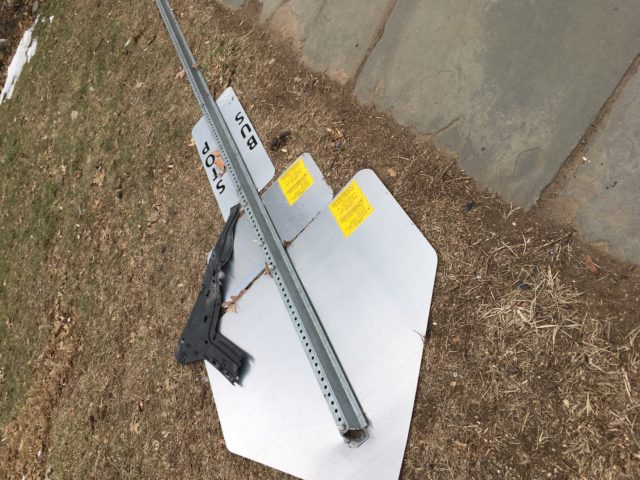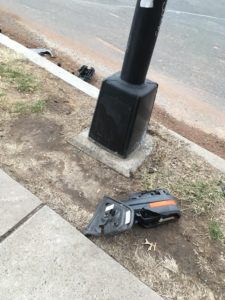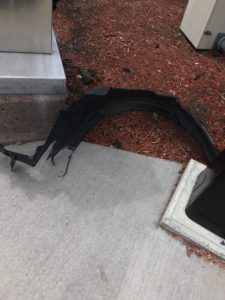
When we talk about litter, the conversation turns to personal responsibility and civic pride, as it should. Adding municipal trash barrels to make doing the right thing more convenient gets suggested. Educating youth about making better choices is a given. What rarely comes up in these discussions, though, is the litter resulting from car crashes.
 On the average day, there are a handful of reported car wrecks in Hartford. If you walk around city streets at all, you are familiar with the current practice of wreckage being left in the gutter, on sidewalks, and lawns. Someone typically manages to move the large trash to the side of the road or sidewalk, but then it sits. Sidewalk trash is still trash, and often, an unnecessary obstacle, particularly for those using mobility aids.
On the average day, there are a handful of reported car wrecks in Hartford. If you walk around city streets at all, you are familiar with the current practice of wreckage being left in the gutter, on sidewalks, and lawns. Someone typically manages to move the large trash to the side of the road or sidewalk, but then it sits. Sidewalk trash is still trash, and often, an unnecessary obstacle, particularly for those using mobility aids.
My walk to work takes me by a telephone pole that has been knocked down in a median/island/grassyknoll for three months. I know this because I reported it to 311 and check back routinely to report that the pole is still there. The 311 app considers this case to be completed.
This is right next to an elementary school.
This same intersection is routinely covered in broken glass, rims, and pieces of bumpers. The divided roadway sign on a median seems to get knocked over (in a crash) on average every six weeks. This should tell us something. The numbers indicate that there is, on average, a minimum of one reported crash at this intersection of Park Terrace and Russ Street every month. Last November, this site saw four crashes.
This is just one of the intersections I pass through where waiting to cross the street means standing in broken glass.
 If we are concerned with personal responsibility, then why is it not applied in this situation that arises time and again? Most of these wrecks do not result in ambulance rides, so I have to wonder why drivers aren’t cleaning up the messes they’ve created.
If we are concerned with personal responsibility, then why is it not applied in this situation that arises time and again? Most of these wrecks do not result in ambulance rides, so I have to wonder why drivers aren’t cleaning up the messes they’ve created.
That may be expecting too much.
The police and paramedics should not be tasked with acting as janitors.¹
This does raise the question of why the Department of Public Works is not dispatched to remove the debris following each crash to which police are summoned.
How would we pay for this? The motorist who is found to be at fault for the crash and is cited by police should be billed for damages and cleaning services.
¹ That said, the practice of leaving spent blue latex gloves on scenes needs to stop. Gross. There is a hazmat protocol. Let’s follow it.
Trippin’ on Litter
When we talk about litter, the conversation turns to personal responsibility and civic pride, as it should. Adding municipal trash barrels to make doing the right thing more convenient gets suggested. Educating youth about making better choices is a given. What rarely comes up in these discussions, though, is the litter resulting from car crashes.
My walk to work takes me by a telephone pole that has been knocked down in a median/island/grassyknoll for three months. I know this because I reported it to 311 and check back routinely to report that the pole is still there. The 311 app considers this case to be completed.
This is right next to an elementary school.
This same intersection is routinely covered in broken glass, rims, and pieces of bumpers. The divided roadway sign on a median seems to get knocked over (in a crash) on average every six weeks. This should tell us something. The numbers indicate that there is, on average, a minimum of one reported crash at this intersection of Park Terrace and Russ Street every month. Last November, this site saw four crashes.
This is just one of the intersections I pass through where waiting to cross the street means standing in broken glass.
That may be expecting too much.
The police and paramedics should not be tasked with acting as janitors.¹
This does raise the question of why the Department of Public Works is not dispatched to remove the debris following each crash to which police are summoned.
How would we pay for this? The motorist who is found to be at fault for the crash and is cited by police should be billed for damages and cleaning services.
¹ That said, the practice of leaving spent blue latex gloves on scenes needs to stop. Gross. There is a hazmat protocol. Let’s follow it.
Related Posts
No Debate Who Won The Debate
How To Make A Sculpture Seem Less Mansplainy
In Your Neighborhood: Downtown